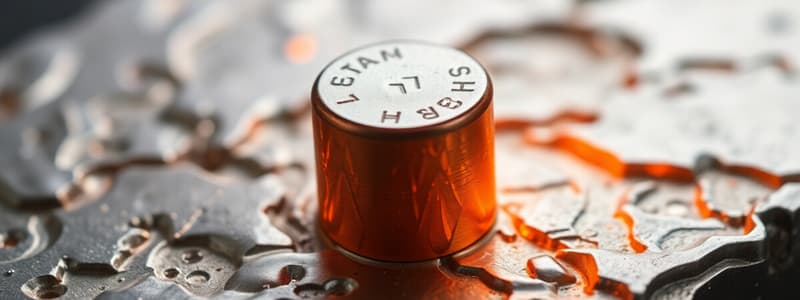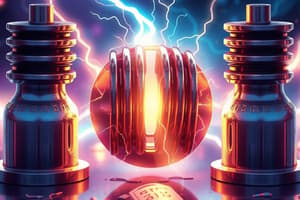Podcast
Questions and Answers
Which metal is known as the best electrical conductor?
Which metal is known as the best electrical conductor?
- Aluminum
- Copper
- Iron
- Silver (correct)
Graphite is a poor conductor of electricity.
Graphite is a poor conductor of electricity.
False (B)
What is the primary reason why metals are used in cooking utensils?
What is the primary reason why metals are used in cooking utensils?
They readily conduct heat energy.
______ is an example of a metal that is commonly used in electrical fittings.
______ is an example of a metal that is commonly used in electrical fittings.
What are the two broad categories of elements?
What are the two broad categories of elements?
Match the following materials with their described properties:
Match the following materials with their described properties:
Which of the following is a property that is generally true for metals?
Which of the following is a property that is generally true for metals?
Iodine is a non-metal that has a shiny appearance.
Iodine is a non-metal that has a shiny appearance.
Pure substances can consist of different kinds of atoms or molecules.
Pure substances can consist of different kinds of atoms or molecules.
What is the hardest substance known?
What is the hardest substance known?
Define what is meant by 'classification of elements'.
Define what is meant by 'classification of elements'.
Which metal is the most abundant in the Earth's crust?
Which metal is the most abundant in the Earth's crust?
Most metals are ______ and can withstand high pressure without deforming.
Most metals are ______ and can withstand high pressure without deforming.
Materials made of the same kind of particles are known as __________.
Materials made of the same kind of particles are known as __________.
All metals occur in their found state in nature.
All metals occur in their found state in nature.
Match the following terms with their definitions:
Match the following terms with their definitions:
What is the term for a mineral from which one or more metals can be extracted profitably?
What is the term for a mineral from which one or more metals can be extracted profitably?
Match the following elements with their state at room temperature:
Match the following elements with their state at room temperature:
Mercury is the only metal that is ______ at room temperature.
Mercury is the only metal that is ______ at room temperature.
Match the metal with its corresponding property:
Match the metal with its corresponding property:
What is malleability?
What is malleability?
Non-metals are generally ductile.
Non-metals are generally ductile.
What is formed when magnesium ribbon burns in oxygen?
What is formed when magnesium ribbon burns in oxygen?
Name one metal that is commonly used for electrical wires.
Name one metal that is commonly used for electrical wires.
The solution formed by dissolving magnesium oxide in water is acidic.
The solution formed by dissolving magnesium oxide in water is acidic.
Metals have high ________ strength due to their ductility and malleability.
Metals have high ________ strength due to their ductility and malleability.
What color does red litmus paper turn when dipped in an alkaline solution?
What color does red litmus paper turn when dipped in an alkaline solution?
Match the following properties of metals with their definitions:
Match the following properties of metals with their definitions:
High reactivity to oxygen is characteristic of metals such as potassium, sodium, and __________.
High reactivity to oxygen is characteristic of metals such as potassium, sodium, and __________.
Match the following activities with their outcomes:
Match the following activities with their outcomes:
Which physical property is characteristic of metals?
Which physical property is characteristic of metals?
Non-metals typically have high melting and boiling points.
Non-metals typically have high melting and boiling points.
What does magnesium oxide dissolve in water to form?
What does magnesium oxide dissolve in water to form?
All metals are in solid state, except for __________.
All metals are in solid state, except for __________.
Match the following properties to their corresponding categories:
Match the following properties to their corresponding categories:
Which of the following is NOT a typical property of metals?
Which of the following is NOT a typical property of metals?
All non-metals are brittle.
All non-metals are brittle.
Potassium reacts with water to form __________.
Potassium reacts with water to form __________.
Which gas is produced when magnesium reacts with water?
Which gas is produced when magnesium reacts with water?
Iron reacts readily with water.
Iron reacts readily with water.
What is the indicator used to test the acidity of carbon dioxide in water?
What is the indicator used to test the acidity of carbon dioxide in water?
When charcoal burns in the presence of oxygen, it produces __________.
When charcoal burns in the presence of oxygen, it produces __________.
Match the metal with its observed reaction:
Match the metal with its observed reaction:
What is the product of burning charcoal with oxygen?
What is the product of burning charcoal with oxygen?
Zinc reacts with water as vigorously as magnesium.
Zinc reacts with water as vigorously as magnesium.
What protective layer prevents further oxidation in aluminum cookware?
What protective layer prevents further oxidation in aluminum cookware?
What gas is evolved when magnesium reacts with water?
What gas is evolved when magnesium reacts with water?
Copper reacts with water to produce hydrogen gas.
Copper reacts with water to produce hydrogen gas.
What indication shows that hydrogen gas is evolved during the acid reaction?
What indication shows that hydrogen gas is evolved during the acid reaction?
Some metals, like _______ and ______, react vigorously with water.
Some metals, like _______ and ______, react vigorously with water.
Match the metals with their reactivity with acids:
Match the metals with their reactivity with acids:
What should be done to prevent reactive metals from reaction with air?
What should be done to prevent reactive metals from reaction with air?
All non-metals react with water.
All non-metals react with water.
What are the two chemical forms produced when magnesium reacts with water?
What are the two chemical forms produced when magnesium reacts with water?
What gas is released when metals react with dilute acids?
What gas is released when metals react with dilute acids?
Copper reacts with dilute hydrochloric acid to liberate hydrogen gas.
Copper reacts with dilute hydrochloric acid to liberate hydrogen gas.
What is produced when aluminum reacts with sodium hydroxide and water?
What is produced when aluminum reacts with sodium hydroxide and water?
Certain food items should not be stored in ______ utensils due to acid reactions.
Certain food items should not be stored in ______ utensils due to acid reactions.
Which of the following does NOT typically react with dilute acids?
Which of the following does NOT typically react with dilute acids?
Match the following metals to their behavior with acids:
Match the following metals to their behavior with acids:
Most metals do not react with alkalis to release hydrogen gas.
Most metals do not react with alkalis to release hydrogen gas.
Potassium is the most ______ metal.
Potassium is the most ______ metal.
Flashcards
Classification of Elements
Classification of Elements
Elements with similar properties are grouped together.
Pure substances
Pure substances
Substances made up of the same kind of particles.
Metals
Metals
Elements that are typically shiny, malleable, ductile, and good conductors of heat and electricity.
Non-metals
Non-metals
Signup and view all the flashcards
Why classify elements?
Why classify elements?
Signup and view all the flashcards
What is Malleability?
What is Malleability?
Signup and view all the flashcards
What is Ductility?
What is Ductility?
Signup and view all the flashcards
What is Tensile Strength?
What is Tensile Strength?
Signup and view all the flashcards
What is Conductivity?
What is Conductivity?
Signup and view all the flashcards
How does conductivity differ in metals and non-metals?
How does conductivity differ in metals and non-metals?
Signup and view all the flashcards
Mineral
Mineral
Signup and view all the flashcards
Ore
Ore
Signup and view all the flashcards
Concentration of Ore
Concentration of Ore
Signup and view all the flashcards
Reduction
Reduction
Signup and view all the flashcards
Refining of Metal
Refining of Metal
Signup and view all the flashcards
Metallic Lustre
Metallic Lustre
Signup and view all the flashcards
Hardness of Metals
Hardness of Metals
Signup and view all the flashcards
Density of Metals
Density of Metals
Signup and view all the flashcards
Melting and Boiling Points of Non-Metals
Melting and Boiling Points of Non-Metals
Signup and view all the flashcards
Brittleness of Non-Metals
Brittleness of Non-Metals
Signup and view all the flashcards
Thermal Conductivity
Thermal Conductivity
Signup and view all the flashcards
Good Thermal Conductors
Good Thermal Conductors
Signup and view all the flashcards
Electrical Conductivity
Electrical Conductivity
Signup and view all the flashcards
Good Electrical Conductors
Good Electrical Conductors
Signup and view all the flashcards
Insulators
Insulators
Signup and view all the flashcards
Metal + Oxygen -> Oxide
Metal + Oxygen -> Oxide
Signup and view all the flashcards
Exothermic Reaction
Exothermic Reaction
Signup and view all the flashcards
Alkali
Alkali
Signup and view all the flashcards
Metallic Oxide
Metallic Oxide
Signup and view all the flashcards
Litmus Paper Test
Litmus Paper Test
Signup and view all the flashcards
Melting point difference between metals and non-metals
Melting point difference between metals and non-metals
Signup and view all the flashcards
Density difference between metals and non-metals
Density difference between metals and non-metals
Signup and view all the flashcards
Malleability and ductility of metals vs non-metals
Malleability and ductility of metals vs non-metals
Signup and view all the flashcards
Conductivity of metals vs non-metals
Conductivity of metals vs non-metals
Signup and view all the flashcards
Reaction of metals with oxygen
Reaction of metals with oxygen
Signup and view all the flashcards
Physical state of metals
Physical state of metals
Signup and view all the flashcards
Physical state of non-metals
Physical state of non-metals
Signup and view all the flashcards
Sonorosity of metals
Sonorosity of metals
Signup and view all the flashcards
How does Magnesium react with water?
How does Magnesium react with water?
Signup and view all the flashcards
How does Iron react with water and acids?
How does Iron react with water and acids?
Signup and view all the flashcards
How does Zinc react with water and acids?
How does Zinc react with water and acids?
Signup and view all the flashcards
What is an Exothermic Reaction?
What is an Exothermic Reaction?
Signup and view all the flashcards
What are Characteristics of Non-Metal Oxides?
What are Characteristics of Non-Metal Oxides?
Signup and view all the flashcards
How does Aluminum Oxide Protect Aluminum Cookware?
How does Aluminum Oxide Protect Aluminum Cookware?
Signup and view all the flashcards
What is the Vigor of a Chemical Reaction?
What is the Vigor of a Chemical Reaction?
Signup and view all the flashcards
What happens when Metals react with Oxidizing Agents?
What happens when Metals react with Oxidizing Agents?
Signup and view all the flashcards
Reaction of Metals with Acids
Reaction of Metals with Acids
Signup and view all the flashcards
Reaction of Metals with Water
Reaction of Metals with Water
Signup and view all the flashcards
Hydrogen Gas Test
Hydrogen Gas Test
Signup and view all the flashcards
Heat-Assisted Reaction
Heat-Assisted Reaction
Signup and view all the flashcards
Metal + Water Reaction
Metal + Water Reaction
Signup and view all the flashcards
Highly Reactive Metals
Highly Reactive Metals
Signup and view all the flashcards
Unreactive Metals
Unreactive Metals
Signup and view all the flashcards
Reactive Non-Metals
Reactive Non-Metals
Signup and view all the flashcards
Reaction of Metals with Dilute Acids
Reaction of Metals with Dilute Acids
Signup and view all the flashcards
Metals that Don't React with Dilute HCl
Metals that Don't React with Dilute HCl
Signup and view all the flashcards
Non-metals and Acids
Non-metals and Acids
Signup and view all the flashcards
Metals that React with Alkalis
Metals that React with Alkalis
Signup and view all the flashcards
Reactivity of Metals
Reactivity of Metals
Signup and view all the flashcards
Finding Reactive Metals
Finding Reactive Metals
Signup and view all the flashcards
Avoiding Metal Reactions with Acids in Food
Avoiding Metal Reactions with Acids in Food
Signup and view all the flashcards


